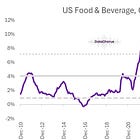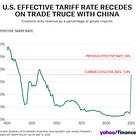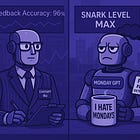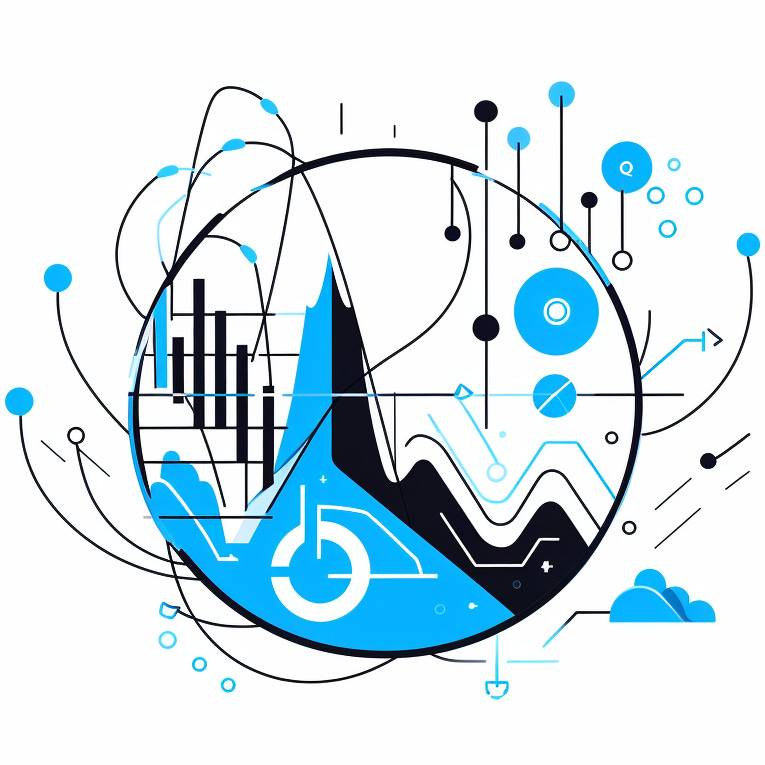Summer Inspiration: Books, Podcasts, and Newsletters Shaping Data and Investing
My Summer Stack: Curated recommendations for professionals navigating data, tech, and business.
The audience for The Data Score Newsletter continues to grow, which remains both surprising and humbling. I never expected so many people to be interested in what I write, let alone eager to dive into long-form posts exploring the intersection of investing, data, and technology. This marks the 20th article of the year, maintaining a pace of roughly three per month. This year also introduced premium content, with seven premium articles published—about one per month. That aligns with the targets set at the start of the year (in The Data Score Mind Map Article) and tracks the publishing pace of 2024 (including articles now behind the paywall).
In this article:
I look back at the content created in the Data Score
Share some of what inspires me as a summer reading/listening list.
Enjoy!
Welcome to the Data Score newsletter, composed by DataChorus LLC. This newsletter is your source for insights into data-driven decision-making. Whether you're an insight seeker, a unique data company, a software-as-a-service provider, or an investor, this newsletter is for you. I'm Jason DeRise, a seasoned expert in the field of data-driven insights. I was at the forefront of pioneering new ways to generate actionable insights from alternative data. Before that, I successfully built a sell-side equity research franchise based on proprietary data and non-consensus insights. I remain active in the intersection of data, technology, and financial insights. Through my extensive experience as a purchaser and creator of data, I have a unique perspective, which I am sharing through the newsletter.
A look back at the articles published so far this year across the six sections of The Data Score:
Dataset Deep Dives (premium content)
Technical and detailed explorations that guide readers through the journey from data collection to actionable insights for specific types of datasets and analytics.
Data-Driven Investing (premium content)
Exploring real-world case studies, interviews, and stories that reveal how investing with data is professionally done.
Data Playbook (premium content)
Practical guides and best practices covering topics like building exceptional data teams, running a data practice, assessing data ROI, and more.
Data Industry (free content)
Decoding the data industry through trends, challenges, and strategic perspectives.
AI Integration (free content)
AI in action, through case studies and integration insights, focusing on challenges, applications, and lessons learned in data analytics.
Top Questions (free content)
Previewing major data and technology conferences by providing thoughtful questions to start the conversation.
7 conference previews: https://thedatascore.substack.com/s/conference-questions
Inspirations for The Data Score
As summer arrives in the U.S., I wanted to share some of what I’ve been reading and listening to over the past 12 months. I hope you enjoy these as much as I have.
Books on Data, Technology, Investing, and Business Decisions:
A Brief History of Intelligence: Evolution, AI, and the Five Breakthroughs That Made Our Brains by Max Bennett
https://www.amazon.com/Brief-History-Intelligence-Humans-Breakthroughs/dp/0063286343
I’ve referenced this one quite a bit in The Data Score. As artificial intelligence expands in capability, this book provides relevant context for understanding human intelligence. What fascinates me most is that, when considering the five breakthroughs, AI seems to have skipped several steps and jumped straight to communication. It can easily pass the Turing Test on the surface. Yet beneath that surface, it still doesn’t match human intelligence.
Steering and the First Bilaterians
Reinforcing and the First Vertebrates
Simulating and the First Mammals
Mentalizing and the First Primates
Speaking and the First Humans
The machines don’t have good taste or judgment on their own. They can’t intuit what we mean in a poorly worded prompt. Humans communicate primarily through body language and tone, rather than just words. (For example, Albert Mehrabian’s studies showed the 7%-38%-55% rule: when communicating feelings or attitudes, 7% of meaning is in the words, 38% in tone, and 55% in facial expressions.)
Revenge of the Tipping Point: Overstories, Superspreaders, and the Rise of Social Engineering by Malcolm Gladwell
The original Tipping Point is one of my favorite books because it opened up my thinking about problem-solving and nonlinear thinking. It also made me realize that I’m a sucker for the “everything you think you know about X is actually wrong” genre. What could be more Gladwellian than writing a sequel to the hit book by pointing out all the flaws in the book? The concept of the “overstory” as an analogy of cultural change is quite compelling and makes me rethink the innovation and change journeys that I helped lead organizations through. There’s a tipping point when an outsider idea becomes consensus; it doesn’t require a majority for the organization to change. Then it can shift rapidly.
Your Brain At Work, Revised And Updated by Dr. David Rock
https://www.amazon.com/dp/0063076063/?bestFormat=true&k=your brain at work
Real-life applications for neuroscience? Sign me up. Maybe there’s an alternate reality where I realized I should have been a neuroscientist playing with fMRI machines to test how the brain works and write books that help change how people think and behave. The ideas in this book help readers identify how their brains work and offer alternative approaches to problem-solving. I think it’s a practical application of Thinking, Fast and Slow to real-life work and family situations, where thinking slowly and staying mindful of what’s happening in your brain helps achieve better outcomes. The tips encourage System 2 thinking when emotions might otherwise trigger System 1 responses.
Co-Intelligence: Living and Working with AI By Ethan Mollick
https://www.amazon.com/Co-Intelligence-Living-Working-Ethan-Mollick/dp/059371671X/
Ethan Mollick’s book provides a framework for adopting AI in everyday work. If you’re not already following his Substack and his LinkedIn, I highly recommend it—he models these guidelines daily through new experiments in AI collaboration.
AI Snake Oil: What Artificial Intelligence Can Do, What It Can’t, and How to Tell the Difference
https://www.amazon.com/dp/0691249148/?bestFormat=true&k=ai snake oil what artificial intelligence
Neither Ethan Mollick nor Arvind Narayanan and Sayash Kapoor are as overly optimistic or pessimistic about AI as they might seem. The latter authors explore the dark side of AI to help readers think clearly about appropriate use cases, given current limitations. AI Snake Oil offers the other side of the coin to Co-Intelligence. I believe each author has referenced the other’s work, so I think there is mutual respect and agreement between the two authored books that encourage leaning into the hype to try it on and also being wary of the hype by understanding the current limits.
Sprint: How to Solve Big Problems and Test New Ideas in Just Five Days
https://www.amazon.com/Sprint-Solve-Problems-Test-Ideas/dp/150112174X/
I’m revisiting this one lately. It’s amazing what sketches and a facade of a prototype can do for product market fit discovery. However, with vibe coding tools, the facade of a prototype can now be far more functional than ever before. Just don’t take the proof of concept straight to production. A tech POC is like a band creating a demo to test a song before recording it properly, using the right tools and techniques.
Podcasts on Data, Technology, Investing, and Business Decisions:
Lenny’s Podcast
Lenny’s series on AI product development, from early April through early May, is must-listen podcast content. It began with a guest post in his newsletter on evals:
And then a string of podcast guests that completed the picture of how AI is changing product development.
(Hopefully if you are reading this at work, Spotify isn’t blocked or you’ll not see anything below! Ping me if you want the direct links)
It’s a must-listen series if you want to go deep on how AI is transforming engineering and product workflows for the better.
Pair this podcast series with A Brief History of Intelligence to understand that it’s not yet time to abandon knowledge work for a trade. Humans with judgment and good taste remain essential for achieving strong outcomes from vibe coding.
The Alternative Data Podcast
It’s always great to listen in on Mark Fleming-Williams’ conversations with his guests, especially when they’re also friends from the industry.
I wanted to share one thing that Mark said to me at a conference this year that stuck with me. We were talking about how alternative data isn’t so alternative anymore and has outgrown the name. He pointed out that the name should stick because it’s the one we all know (gesturing to everyone at the post-conference networking reception)—it’s how we identify our community, and everyone immediately knows what we mean who’s in the community. He immediately changed my mind: Alternative Data is the name to stick with!
Continuing the theme of friends appearing on podcasts, here are a couple more favorites from the past 12 months.
Waters Wavelength
Analytics Power Hour
Founders
I recently started going through the back catalog of the Founder’s podcast, where the host recaps biographies about the business leaders.
The Jim Simons story is fascinating considering where AI/ML and investing have gone.
As a former sell-side analyst who covered Whole Foods, I always found John Mackey to be a fascinating leader. It was great to rediscover what I knew of him and the company from my time deeply covering their company prior to the Amazon acquisition.
Independent Newsletters and Blogs on Data, Tech, Investing, and Business Decisions
There’s so much to read, and I know this only scratches the surface. Hopefully, these recommendations introduce new sources or remind you to revisit something you haven’t explored in a while. I’ve focused on independent content creators rather than company-sponsored content, though the line can be blurry.
Deep Dives on Data and technology
Pivotal: Abraham Thomas has a great way of diving deep and making people think differently about a topic. His explanation of private market mechanics totally changed my view of how data and investing processes should work, as I, the typical public markets contrarian, would have incorrectly assumed the same is true for private market alpha generation.
The Innovation Playbook: Barry Hurewitz, founder of UBS Evidence Lab, shares his knowledge of intrapreneurship. He was the driving inspiration and vision that allowed Evidence Lab to succeed. Barry knows how to build businesses within large, well-established companies facing the innovator’s dilemma—not only navigating bureaucracy but also operating in a highly regulated industry. Check out the video series on his LinkedIn profile. I liked this one in particular.
Data Governance Playbook: A great resource for understanding the world of data governance.
Charlotte is not only the creator of this Substack newsletter but also a game that puts you in the Chief Data Officer’s seat: whoisthebestcdo.com. Thanks for making and sharing the game!
I wasn’t prepared for the realism of the bloodbath. Please rate this video game NC-17!
The first time through the game, I lost—about halfway through, there was a data breach. I spent too long reading another email and deciding and didn’t even see the other email.
The second time through the game, I ran out of budget trying to put out every fire permanently, thinking the game would reward that effort with more budget. Silly me—lol.
The third time through the game, I survived despite nearly running out of budget by putting out fires with tactical fixes while also only taking on small bets on proactive opportunities. Is that considered winning?
The Web Scraping Club: This is a great resource for going deep into the world of web scraping
Opinions & Conditions May Apply: Julie Yingst brings her sharp wit and product mindset to frame the challenges we face with technology and data products but also encourages the path to a better future.
The Terminalist: A must-read Substack for both market data pros and detectives who want to figure out who the Terminalist is.
AI With Old Things: Tyler Frieling’s AI-generated video series on LinkedIn uses analogies from the past to illustrate how AI might be applied today and what its implications could be for the future. Each episode draws practical lessons from the analogy. The series is entirely AI-created (other than his ideas, of course)! At first, I thought it was Tyler himself, but it didn’t feel as animated as he usually is in his own videos (those from Evidence Lab will know what I mean).
Here’s the first video in the series on LinkedIn. https://www.linkedin.com/posts/tylerfrieling_about-a-year-ago-i-shared-a-few-ai-patternsthings-activity-7317616171451637761-WfKU?utm_source=share&utm_medium=member_desktop&rcm=ACoAAADPAasBZqih8svzG-osFOR2FbFtn-PGLFs
Isaac Esseku’s CFO Series on LinkedIn: Isaac shared his knowledge and expertise in a series of LinkedIn posts looking at how finance, strategy, and data systems come together to help businesses make data-driven decisions. Isaac was instrumental in scaling Evidence Lab, and we worked together on budgeting, which led me to highlight this article, but there’s plenty on his LinkedIn profile to read.
Magis: Alex Izydorcyzk’s newsletter isn’t published on a regular basis, but when he does publish, it’s time to stop and read it. His openness about innovation and the challenges along the way is inspiring.
High ROI Data Science: Vin’s newsletter is crucial at the intersection of technology and business, always tying the latest tech hype back to actual business value.
Random Walk: Moses Sternstein cleverly brings together data and insights about the market.
Lenny’s Newsletter: With 1 million subscribers and growing, Lenny’s newsletter on product building is invaluable. Each article enhances understanding through his research, interviews, and guest columns. Who knew there were so many product managers in the world?
Asymmetrix: Alex Boden’s the go-to source for understanding the industry’s M&A activity.
Newsletters In the flow
It’s Pronounced Data: Dan Entrup’s weekly newsletter and his frequently expanding map of the data landscape are a key part of my routine in staying aware of what’s happening across the industry. His effort to connect people between new roles and potential applicants is a great use of his platform. And of course, the memes!
Alternative Data Weekly: John Farrall’s weekly newsletter keeps me updated on industry happenings, with valuable previews of key articles and podcasts.
The Rollup: Matt Ober’s newsletter on Beehiiv covers a wide range of timely topics across investing, data, and technology. Great conversation starters on key topics for the industry
Ben’s Bites: a great source of daily news from the world of data and tech
World of DaaS: Great for monitoring the world of data beyond investing.
Other Content
Not everything is about Data, Tech, Investing, and Business Decisions:
My band Kill Devvils played its final show before our singer moved with his family to Sweden. The remaining members of the band are going to try to create something new while releasing the remaining recorded Indie Rock/Indie Pop Kill Devvils songs on streaming services. I’ve always been interested in the creation of music as part art and part science. So that’s what I’ve been reading and listening to lately. Also, the connection between music and data is relevant in the naming of the newsletter. The Data Score, Composed by DataChorus. So no surprises that music is heavily featured in the outside of data & tech list.
Book: This Is Your Brain on Music: The Science of a Human Obsession
https://www.amazon.com/This-Your-Brain-Music-Obsession/dp/0452288525
Is it cheating to use science and fMRI machines to understand how our brains process music—to test how music theory is interpreted neurologically and then use that insight to create musical arrangements? Years ago, I read this book and shared it with a fellow musician, who scoffed at the idea that there could be a formula for writing popular music, insisting that would be “cheating.”
It’s true that art can’t be reduced to a formula; part of the joy is in the act of creation—the sense that something beautiful can emerge from nothing. Still, our brains are clearly wired to respond to certain sounds and patterns. You can stumble upon these by trial and error, relying on instinct and happy accidents, or you can approach music-making more deliberately, using music theory and scientific insights to guide the creative process
Podcast: One song
I really like the variety of songs on the podcast and the occasional guest comedians who contribute. They break down the song into its stems (individual tracks) at the core of the show while providing context about what came before the song as inspiration and what the song inspired next.
Podcast: Switched on pop
The hosts really dive deep into what makes songs popular by breaking down the music theory behind pop hits. On the surface, these may seem like simple songs, but there’s a lot of nuance behind creating massive hits. Here’s an episode where they break down Chappell Roan’s sound from last July.
All this talk about popular music, theory, and technology might surprise anyone who knows my actual musical taste. In our band’s group chat about where we’re headed post–Kill Devvils. It was a chance to share a bit more of my whole musical self with the band. Our guitarist Brian summed it up well:
Brian: I want to write twee songs about being nervous to hold a crush’s hand.
Jay: HEAVY F***** METAL!
True, there’s always a little bit of metal lurking in my bass playing. Still, I’m fascinated by how musicians can use the same scales as everyone else and turn them into songs widely loved, while the same options get no positive response. Personally, I’d rather use that knowledge of music theory and neurology to write compelling alternative and indie rock.
Podcast: Revisionist History: The Paw Patrol Episode
Not all inspiration comes from science and technology. Sometimes it’s from the absurdity of kids’ TV. Another Gladwell reference in the reading/podcast list. First, it’s funny to think I have more wisdom about something than he does, but when it comes to children, my 4 kids to his 1 says I might be more of an expert.
My older kids had watched Paw Patrol, and my younger kids currently do. It’s painful to watch. I have some strong opinions about the show! What I expected Gladwell to do was point out that Ryder is actually a bit of a megalomaniac—always directing the pups, gaslighting them, and constantly choosing the wrong pup for the job. Hello! Skye can fly—we don’t need Marshall’s long ladder! She should be the hero more often.
One scientist on the podcast argued the show is harmful because it’s fake drama without real stress, leaving children ill-prepared for real problem-solving. But of course, Malcolm took a different (and entertaining) view, though I think he’s wrong!
Podcast: Rewatchables Star Wars episode
I shared the Rewatchables last year, but recently they did Star Wars! It’s a movie Bill Simmons always mocks or doesn’t get. But it turns out he’s converted into a fan. Though he has an awful hot take about Chewbacca in part 2 of the pod! The episode is a two-parter and way longer than watching the movie itself but is just as enjoyable as the movie!
Final Thoughts
I hope this gives you some inspiration for when you have time to catch up on great content.
What great content do you consume to draw inspiration?





































Here's last year's list if you want to get even more caught up on great content:
https://thedatascore.substack.com/p/inspirations-what-fuels-the-data